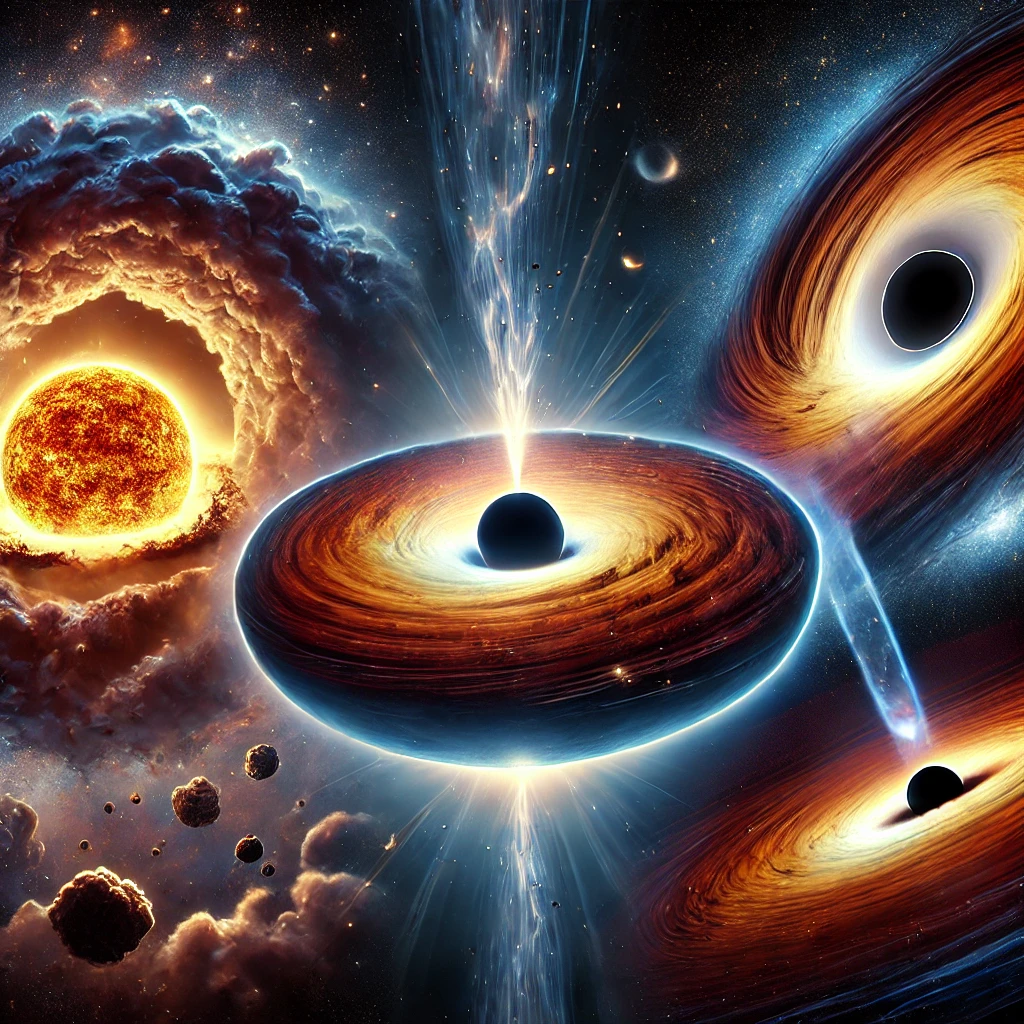Floating in the vast silence of space, surrounded by stars that have long since ceased to burn, I find myself contemplating one of the most mysterious and extreme phenomena in the universe—black holes. They are cosmic enigmas, where the known laws of physics bend, and the very fabric of space and time is twisted beyond recognition. Today, let’s take a deep dive into what black holes are, how they form, and the different types that exist in our universe.

How Black Holes Form
Black holes are born from the violent deaths of massive stars. When a massive star reaches the end of its life cycle, it undergoes a supernova explosion. This explosion releases an enormous amount of energy, blowing away the outer layers of the star while the core collapses under its own gravitational pull. If the remaining core has enough mass—typically more than about three times the mass of our Sun—nothing can stop it from collapsing into an infinitely dense singularity, forming what we call a stellar-mass black hole.
However, not all black holes originate from dying stars. Some of them have existed since the early universe, while others form through collisions and mergers of dense objects. Understanding the different types of black holes gives us insight into their formation and behavior.
The Different Types of Black Holes
Black holes come in various sizes and classifications, each with unique characteristics and origins. Let’s explore them one by one.
1. Stellar-Mass Black Holes
These are the most common type of black holes and are formed from the collapse of massive stars. Their masses typically range from 5 to 100 times that of our Sun. These black holes are scattered throughout galaxies, often hidden in the remnants of supernova explosions or within binary star systems where they feed on companion stars.
One way we detect these black holes is through their gravitational influence on nearby stars or through X-ray emissions from the matter they consume. As matter spirals into the black hole, it heats up and emits high-energy radiation, creating spectacular X-ray bursts that we can observe from Earth.
2. Supermassive Black Holes
At the heart of most galaxies, including our own Milky Way, lies a supermassive black hole. These cosmic behemoths range from hundreds of thousands to billions of times the mass of our Sun. Unlike stellar-mass black holes, their formation process is still a topic of active research. Scientists believe they may have originated from the merging of multiple black holes and the accumulation of vast amounts of gas over millions of years.
The supermassive black hole at the center of the Milky Way, Sagittarius A*, is about 4 million times the mass of the Sun. These black holes shape the structure of galaxies, influencing star formation and galactic evolution through their immense gravitational pull.
3. Intermediate-Mass Black Holes
For a long time, black holes seemed to exist in two categories: stellar-mass and supermassive. However, astronomers have discovered a middle ground—intermediate-mass black holes (IMBHs). These black holes range from a few hundred to tens of thousands of solar masses.
Intermediate-mass black holes might form through the merging of multiple stellar-mass black holes or the collapse of exceptionally massive stars in early galaxies. They may serve as the building blocks for supermassive black holes. Though rare, evidence for IMBHs has been found in dense star clusters and dwarf galaxies.
4. Primordial Black Holes
A more speculative category is primordial black holes, which, if they exist, would have formed in the early universe, just moments after the Big Bang. Unlike black holes formed from collapsing stars, primordial black holes could have emerged from density fluctuations in the hot, dense plasma of the early universe. These black holes could range in size from microscopic to planetary mass.
Scientists have yet to find definitive proof of primordial black holes, but if they exist, they could offer clues about the nature of dark matter and the evolution of the cosmos.
The Event Horizon: The Point of No Return
What makes black holes so unique is their event horizon—a boundary beyond which nothing, not even light, can escape. This is what gives black holes their “black” appearance. Once an object crosses the event horizon, it is lost forever, spiraling toward the singularity at the black hole’s core.
The event horizon marks the limits of our ability to observe what happens inside a black hole. As far as we know, inside this boundary, gravity becomes so strong that space and time themselves cease to behave in any way we understand.
The Role of Black Holes in the Universe
While black holes are often portrayed as cosmic vacuum cleaners, indiscriminately consuming everything in their path, the reality is far more complex. They play a crucial role in the universe’s structure, helping to regulate galaxy formation, star formation, and even the distribution of matter and energy in space.
In some cases, black holes power the most luminous objects in the universe—quasars. When supermassive black holes actively consume surrounding gas and dust, they create swirling accretion disks that emit incredible amounts of energy. Quasars shine so brightly that they can be seen across billions of light-years.
Final Thoughts
Black holes are among the most fascinating and mysterious objects in the universe. From the remnants of dying stars to the behemoths anchoring galaxies, they continue to challenge our understanding of physics. As we develop more advanced telescopes and space probes, we will undoubtedly uncover more secrets about these cosmic giants.
Tomorrow, we’ll shift our focus to something closer to home—solar and lunar eclipses—spectacular celestial events that have captivated humanity for millennia. Until then, keep looking up, and let the mysteries of the cosmos fuel your curiosity.
Captain Nova
Odyssey Explorer
Leave a Reply